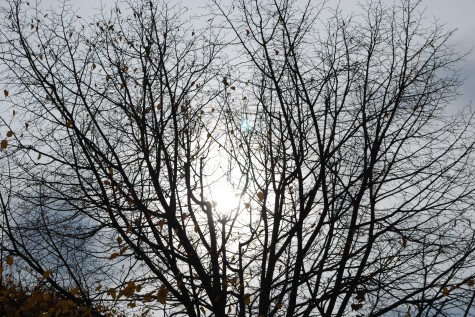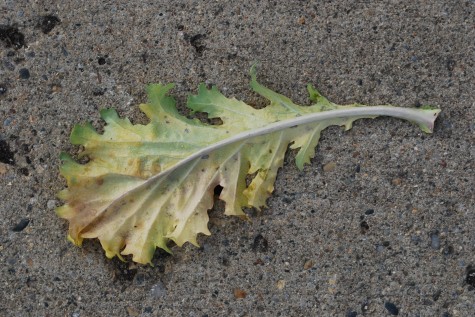One of my favorite clients and dear friends took off this morning for Rome. As hard as it is for me to believe, she insisted my post on Villa D’Este inspired her to go visit her granddaughter who is on foreign study in Rome-and by the way, go see that garden. By this time last week, she had enlisted both of her daughters-one of whom is Carol, the proud Mom of said student Grace. Daughter Diane is an RN living in California-she flew out for the Romefest. Four other friends signed on. She organized an entourage- soon to land in Italy. Tonight, I think.
She has the week ahead planned. A guided visit to the Vatican. Villa D’Este, of course. A request from me for an Italian boater with an orange band. A cooking course she thought sounded like fun. I have no details on this, as once you use the word cooking within my earshot, I black out. Some time she has left to Grace to organize. Her energy puts me to shame.
I am thinking about her, as she loves to travel. She so enjoys the garden tour we do every year; she has been trying to worm out of me for weeks where this year’s tour might take her. She drive-travels straight through to get her granddaughter back to Clemson University in September, and drive-travels again to pick her up at year’s end. She travels in other ways less literal. She considers ideas outside her realm-she is happy to go anywhere, and decide if she likes it. She is a traveller.
I am not a board a vehicle and go traveller. I hate the packing and the time it takes to arrive at a destination. I am not crazy about being away from home. I travel-reluctantly; the process exhausts me. I am always happy to get where I am going-what is not to like about seeing new places. Whomever can convince me to travel-many thanks. When NASA figures out how to beam me up, I will be first in line. On occasion, something or someone will beam me over to what never occurred to me-best regards, and many thanks for this. But I am always thinking about travelling when I design.
I know travel is a key issue in design. Once a mortgage survey is in my hands, my first move is to decide how, why and where one might travel in the landscape. For anyone designing their own landscape, I would encourage them to build some roads in their garden. Some roads need to be two lane. Other roads can be a skinny dirt two-track. Some places need stop signs. Other places need roundabouts. A travel sceme is essential for you, your kids, dogs, and guests. Plan your routes before you decide anything else.
How will you get from the house, to the grill, to the terrace, to the trash, to the rose garden, to the street, to the back door, to the compost pile, to the picnic table-how will you drive through, walk through, and linger in the space? Where will your family and friends congregate? If you were to walk your garden with a video camera running, would a story be told? Expand off road wherever you have a mind to.
No writer/gardener I ever read more clearly and more beautifully addresses the travel particular to the journey of a gardener than Dominique Browning; I have talked about this before. Her discussion of the evolution of her garden has everything to do with travelling through, and lingering here or there. When she is stopped, she is stopped in her tracks. When she moves on to somewhere else, there is a big pair of lopping shears in her hand, and /or significant emotional travel involved.
She has a sense of humor about her basic unwillingness to budge off her comfort spot. She is entirely dispassionate about all of her passions. I admire this in her. Her writing encourages me to loosen up, and move around more. How you will live, perch, lounge, work, read or take a nap are questions that need to be addressed before you make moves.
No matter how glued I am to my place, I put that aside, and encourage myself to take my clients somewhere. Somewhere better than they thought they could have it. Think about this, you people who have a mind to design your own gardens. If you have a notion to hire a designer, first and foremost understand how you will travel through the landscape they have designed for you.
Jane’s travels are much more than I have detailed here. Like all of us, she has roads to travel, like them all or not. Getting control of the layout of those roads may make things easier. Some paths are 25mph quiet zones. Others have lots of traffic. It is important to get this part right. Some badly placed plants can easily be moved-your routes, not so easy to redo. Whether you use a piece of paper, a garden hose, landscape paint, or stakes and strings, taking the time to plan your trip is a good idea.
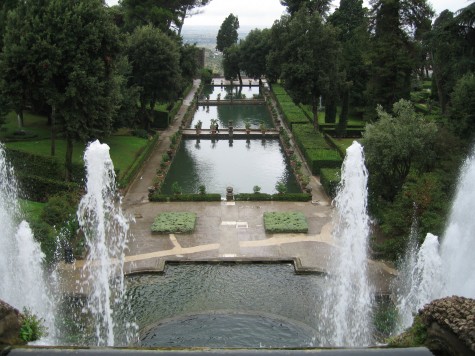
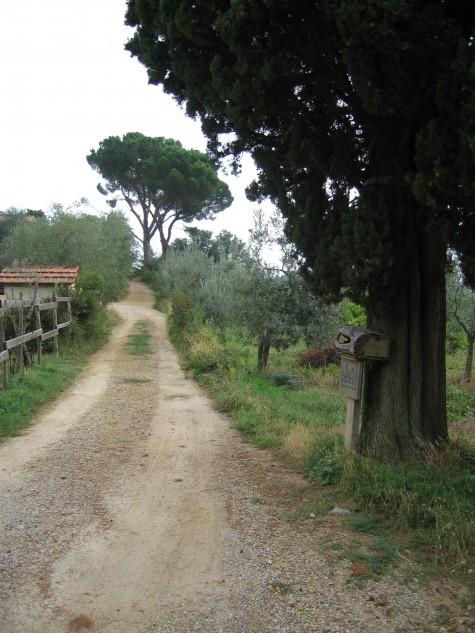
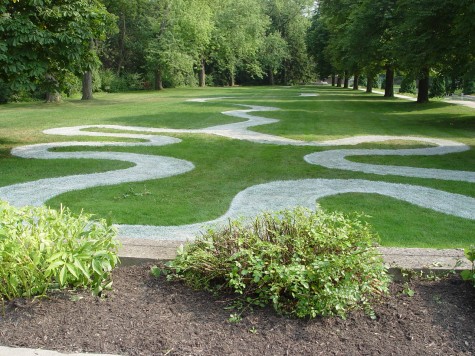
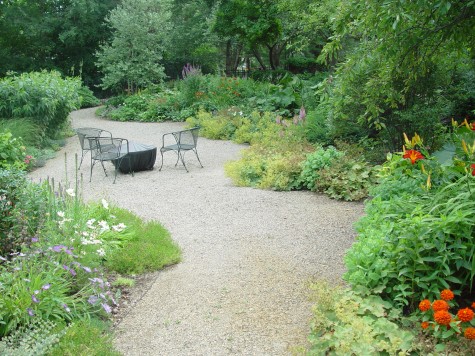
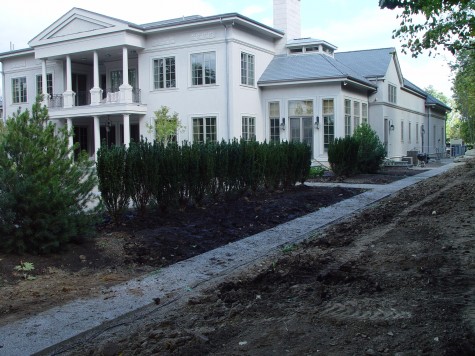

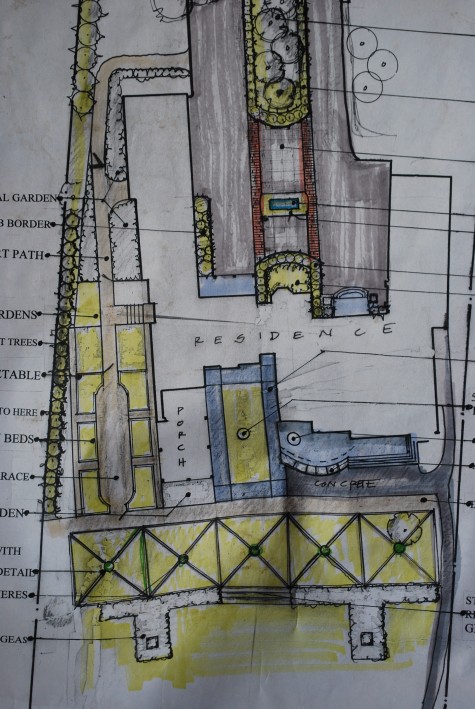
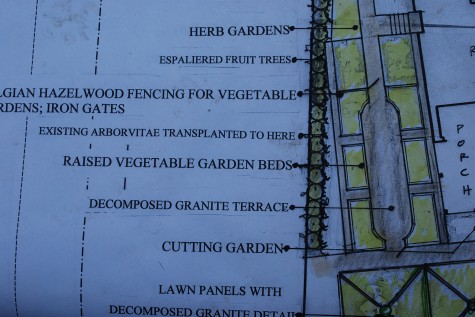
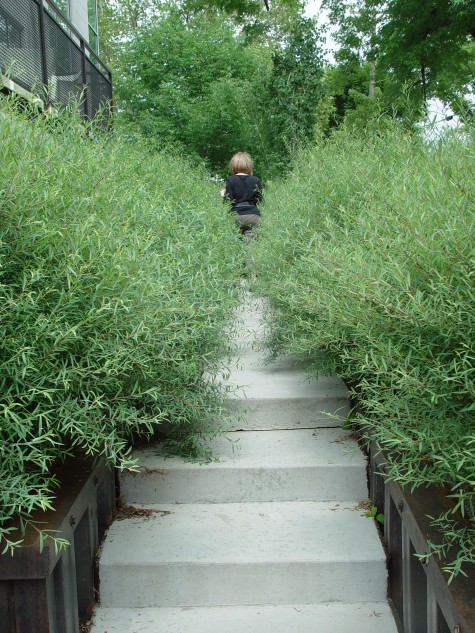

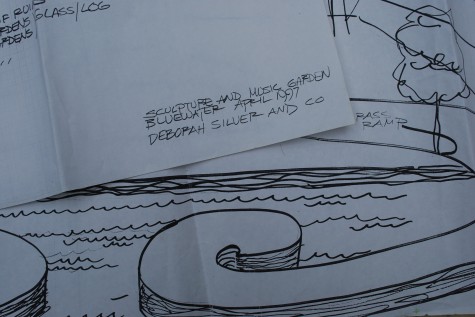 As my layout table has its first new coat of paint in 14 years, all the prints I’ve had stored there are piled up in my office. OK, I couldn’t resist taking a look before I put them back in storage. Some of them entertain me-I can see exactly what was influencing me at the time. The roll of drawings for the Bluewater project was just that-drawings. These unpolished sketches of landscape elements for a commercial project were highly conceptual-and certainly predate any computer programs that are now readily available to designers.
As my layout table has its first new coat of paint in 14 years, all the prints I’ve had stored there are piled up in my office. OK, I couldn’t resist taking a look before I put them back in storage. Some of them entertain me-I can see exactly what was influencing me at the time. The roll of drawings for the Bluewater project was just that-drawings. These unpolished sketches of landscape elements for a commercial project were highly conceptual-and certainly predate any computer programs that are now readily available to designers.  Land forms have always been of great interest to me. A big chunk of my library deals with mazes and labyrinths, land sculpture and earthworks. Robert Smithson’s 1970 sculpture “Spiral Jetty”, constructed in 6 days on a leased piece of the Great Salt Lake in Utah, is now completely landlocked as the lake is so low. The sculpture spent 20 years or better completely submerged. The sculpture has presented in many forms over the past 40 years. I have always admired it; no doubt this conceptual drawing of a maze half in and half out of some water was directly inspired by Smithson’s work.
Land forms have always been of great interest to me. A big chunk of my library deals with mazes and labyrinths, land sculpture and earthworks. Robert Smithson’s 1970 sculpture “Spiral Jetty”, constructed in 6 days on a leased piece of the Great Salt Lake in Utah, is now completely landlocked as the lake is so low. The sculpture spent 20 years or better completely submerged. The sculpture has presented in many forms over the past 40 years. I have always admired it; no doubt this conceptual drawing of a maze half in and half out of some water was directly inspired by Smithson’s work. 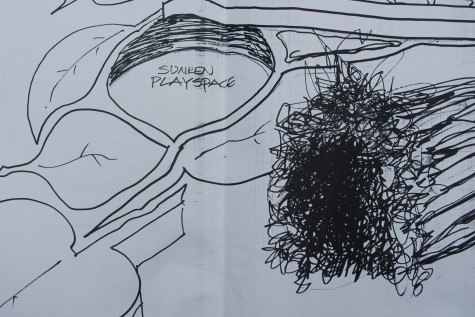 Another favorite-the land form drawings of Hans Dieter Schaal in his book “Landscape as Inspiration”. Inspired indeed. His sprawling and energetic drawings of natural forms exposed me to an entirely different way of thinking about dirt and nature. I had never seen landscape spaces rendered in this way before. I was equally taken with the beauty of the drawings. They are by no means scaled prints, they are gestural and interpretive marks on a page. This work inspired me to take up a marker and put it to a page, and see what happens. I refer to his book regularly.
Another favorite-the land form drawings of Hans Dieter Schaal in his book “Landscape as Inspiration”. Inspired indeed. His sprawling and energetic drawings of natural forms exposed me to an entirely different way of thinking about dirt and nature. I had never seen landscape spaces rendered in this way before. I was equally taken with the beauty of the drawings. They are by no means scaled prints, they are gestural and interpretive marks on a page. This work inspired me to take up a marker and put it to a page, and see what happens. I refer to his book regularly. 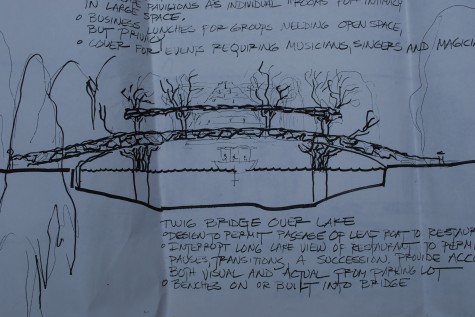 Any reference to natural forms intrigues me. A log twig bridge over Bluewater’s man-made lake seemed like just the right combination of architecture and natural materials. Buck shakes his finger at me when I design with no regard for construction, but I still think a little free spirited doodle drawing has its place. A sketch that seems to be going no where is easily discarded-provided you have not spent so much time with it that you have become attached. It is difficult to be objective about one’s own work-so I try to work fast at the conceptual stage. Anything I have invested a lot of time and work in can be hard to trash-even when trash it I should.
Any reference to natural forms intrigues me. A log twig bridge over Bluewater’s man-made lake seemed like just the right combination of architecture and natural materials. Buck shakes his finger at me when I design with no regard for construction, but I still think a little free spirited doodle drawing has its place. A sketch that seems to be going no where is easily discarded-provided you have not spent so much time with it that you have become attached. It is difficult to be objective about one’s own work-so I try to work fast at the conceptual stage. Anything I have invested a lot of time and work in can be hard to trash-even when trash it I should. 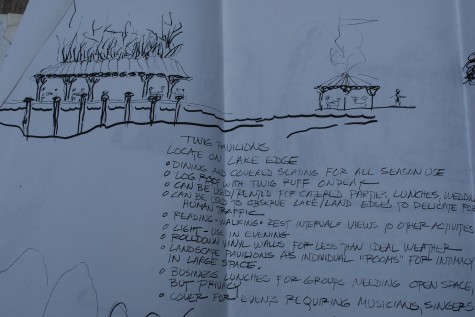 None of these drawings would convince a client to commit their time and money. But they might convince a client that there was a reservoir of ideas from which something of interest might emerge. If you don’t believe your designer is a person of interest, then a collaboration on your project is unlikely. If you are designing for yourself, drawings can bring ideas to the surface you didn’t know you had. Keeping a waste basket handy can be a comfort!
None of these drawings would convince a client to commit their time and money. But they might convince a client that there was a reservoir of ideas from which something of interest might emerge. If you don’t believe your designer is a person of interest, then a collaboration on your project is unlikely. If you are designing for yourself, drawings can bring ideas to the surface you didn’t know you had. Keeping a waste basket handy can be a comfort!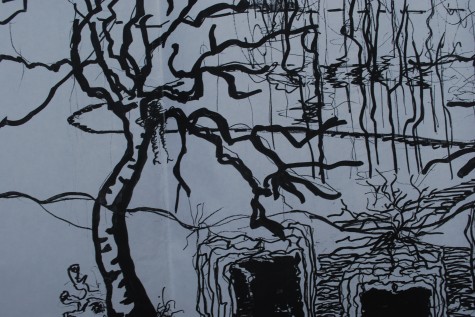 I am happy to have these drawings, not for their design, but for their energy. Being the fan of science that I am, I wholly subscribe to the notion that everything in motion tends to stay in motion-and what’s at rest tends to stay still. This applies as much to a design sensibility as it does to the physical world. Inertia being gravity that has gotten the upper hand, I make the effort to feed whatever energy I have regularly.
I am happy to have these drawings, not for their design, but for their energy. Being the fan of science that I am, I wholly subscribe to the notion that everything in motion tends to stay in motion-and what’s at rest tends to stay still. This applies as much to a design sensibility as it does to the physical world. Inertia being gravity that has gotten the upper hand, I make the effort to feed whatever energy I have regularly. 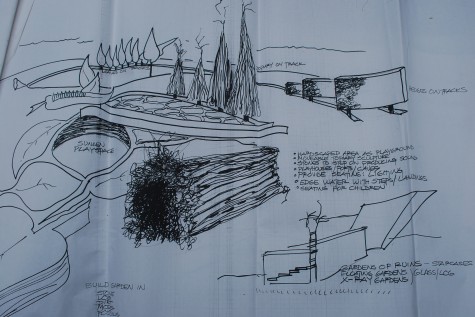 This drawing suggests at least 6 different ideas. They have similar elements, but are disconnected from each other. At the end of a series of drawings comes the integration phase. How visual and sculptural elements relate to each might be more important than any given piece. That relationship provides for good flow and rhythm. I see lots of landscapes that have good bits, but no flow. In the print, I plan for the transition between one space and another to have its own space.
This drawing suggests at least 6 different ideas. They have similar elements, but are disconnected from each other. At the end of a series of drawings comes the integration phase. How visual and sculptural elements relate to each might be more important than any given piece. That relationship provides for good flow and rhythm. I see lots of landscapes that have good bits, but no flow. In the print, I plan for the transition between one space and another to have its own space. 
 The fall is the perfect time to talk about light as an element of design in the landscape. How, when and where the sun shines, dramatically influences the visual impact of any landscape or garden. October light in Michigan is cold and low in the sky. Uneven or carved surfaces are cast in sharp relief. Any shadows cast will be dramatically elongated. A client choosing a smooth surfaced ornament for their garden should be happy for a subtle light rendering; if not, choosing ornament with some more graphic surface variation might be in order.
The fall is the perfect time to talk about light as an element of design in the landscape. How, when and where the sun shines, dramatically influences the visual impact of any landscape or garden. October light in Michigan is cold and low in the sky. Uneven or carved surfaces are cast in sharp relief. Any shadows cast will be dramatically elongated. A client choosing a smooth surfaced ornament for their garden should be happy for a subtle light rendering; if not, choosing ornament with some more graphic surface variation might be in order.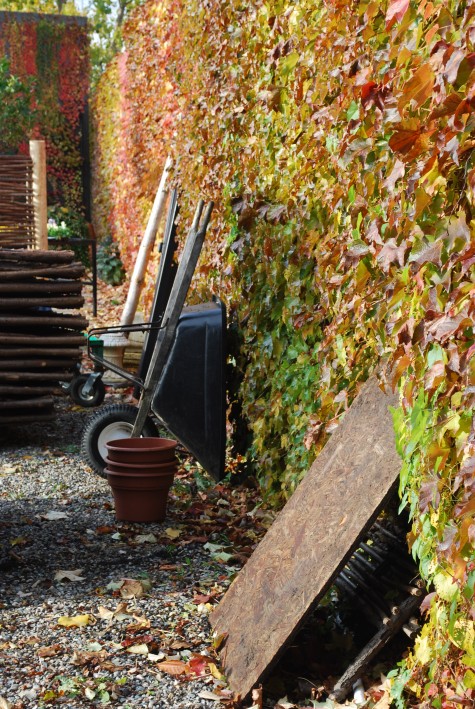 I could write on into the next decade about how light is the engine that gets any outdoor space moving. One of my favorite parts of my Michigan gardening life is how the light can make the appearance of everything change, from hour to hour, and day to day, and season to season. The contrast of light and dark in a garden is its heartbeat. In October, the trees coloring up are all the more dramatic for the ignition supplied by that intensely pale light. Its worth thinking about the degree of shade a tree or shrub will cast in a landscape. A densely shady area is all the more dramatic with a pocket pool of light behind it. Plan for dark spaces close to your view, with light spaces in the distance.
I could write on into the next decade about how light is the engine that gets any outdoor space moving. One of my favorite parts of my Michigan gardening life is how the light can make the appearance of everything change, from hour to hour, and day to day, and season to season. The contrast of light and dark in a garden is its heartbeat. In October, the trees coloring up are all the more dramatic for the ignition supplied by that intensely pale light. Its worth thinking about the degree of shade a tree or shrub will cast in a landscape. A densely shady area is all the more dramatic with a pocket pool of light behind it. Plan for dark spaces close to your view, with light spaces in the distance.  The spring leaves emerging on my Princeton gold maples cannot hold a candle to their yellow fall fire. I am a photographer whose lack of understanding about the mechanics of photography is considerable. So I watch the light. When it suffuses every element in a garden such that the color in my pictures, or the feeling of my pictures, will be saturated-that is the time I photograph. I record; I do not have the skills to generate. It is hard to believe this collection of these maple yellow leaves produces such dense shade underneath; the grey cedar fence appears black by way of contrast, and almost disappears.
The spring leaves emerging on my Princeton gold maples cannot hold a candle to their yellow fall fire. I am a photographer whose lack of understanding about the mechanics of photography is considerable. So I watch the light. When it suffuses every element in a garden such that the color in my pictures, or the feeling of my pictures, will be saturated-that is the time I photograph. I record; I do not have the skills to generate. It is hard to believe this collection of these maple yellow leaves produces such dense shade underneath; the grey cedar fence appears black by way of contrast, and almost disappears.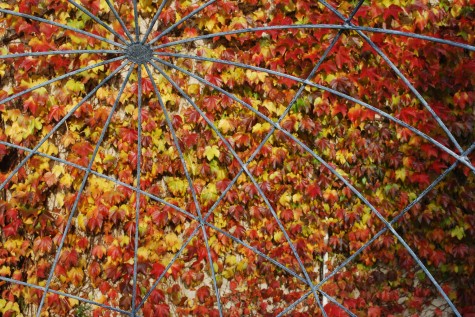 Our thin rod steel spheres permit the view of your choice through to the landscape. How they interact with a garden is the best part about them. Imagine this view in the winter, the early spring, the early summer, the high summer, the fall; you get the idea. Add light to the mix, and your possible visual combinations increase considerably. Garden ornament interests me greatly, given how it offers me a sense of solidity, and steadfast longevity, against the ever changing landscape.
Our thin rod steel spheres permit the view of your choice through to the landscape. How they interact with a garden is the best part about them. Imagine this view in the winter, the early spring, the early summer, the high summer, the fall; you get the idea. Add light to the mix, and your possible visual combinations increase considerably. Garden ornament interests me greatly, given how it offers me a sense of solidity, and steadfast longevity, against the ever changing landscape. 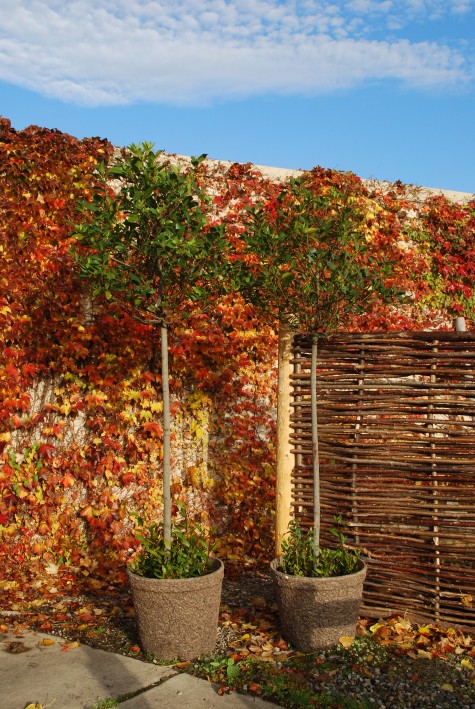 The bright flat October sun sets all it touches on fire. The greens are all that much more electrically green; the reds glow red. If you are looking to see the rhythm established by the masses of light and dark in your landscape, look quick now before the leaves fall. There is instruction coming from the natural world every day, should you care to tune in.
The bright flat October sun sets all it touches on fire. The greens are all that much more electrically green; the reds glow red. If you are looking to see the rhythm established by the masses of light and dark in your landscape, look quick now before the leaves fall. There is instruction coming from the natural world every day, should you care to tune in.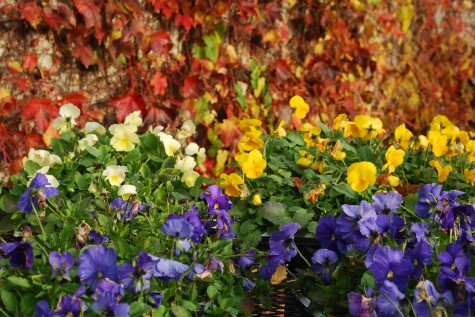 The color of these pansies speaks softly in the spring. The fall light intensifies and electrifies the appearance of their color. On my best days, I think about how the light will fall on a landscape in every season, as this should influence how I place every plant or object.
The color of these pansies speaks softly in the spring. The fall light intensifies and electrifies the appearance of their color. On my best days, I think about how the light will fall on a landscape in every season, as this should influence how I place every plant or object.
